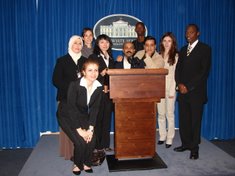I had an exceptional birthday this year, the only celebration was e-wish from my friends. However, it was global.
I felt some a kind of hesitation to tell anybody that my birthday was on Friday and thought let it be a different one. The day began with a sweet tune. When I was reading poems of WB Yeats Thursday evening, I fell asleep. And I had a dream where I saw all my childhood characters some of whom have started fading a little bit from my memory. I woke up happy, still holding Yeat's books, and saw the 15 minutes of the new day, my birthday, has passed.
I got two of my story cleared that day. One was my piece on eBay fraudulent seller which I wrote for Saturday Diary page. It came out Saturday. My mentor Greg Victor, who is in-charge of the page, is a good editor.
I worked half day and watched movie rest of the day, chatted with my wife and some other friends in Bangladesh and one each in Ivory Coast and Switzerland.
As the week began, I continued my work for the story on Pittsburgh-based charity organization Brother's Brother Foundation which has so far sent donations medicine, medical supplies, seeds and books to 121 countries. I was writing a feature on this organization's recent receipt of a huge consignment of surgical instruments worth about $4.8 million. They have already sent the instruments to 28 countries. They are starting distributing Crocs shoes this year among people in need in 30 countries.
When I began working for for the story, my editor told me not to make it a big one. But when I submitted a 730-word story to her Thursday morning, she told me to explain several points, write more about the volunteer doctors and the president of the organization. As I reminded her of her instruction to keep it small, she said it's not going to be that big! And when I added the info, it stood 980 words. It was not still that big!
If I submit a story of this size to my bosses in my home newspaper, they'll yell on my face and throw it away. We have instruction not to write more than 500 words if the story is a major one. Otherwise it won't be more than 350 words.
After submitting my story that day, I asked my editor to let me know when she would edit it. I've decided that I would observe editing of my stories closely to find my mistakes. It's more effective and useful for a writer than reading the story after it comes out. The editors explain to you what they want, what not and what they avoid. Besides, you'll also learn about the newspaper policy.
When I sat with her for editing Friday morning, I realized once again that I can't overcome the British tone in my writing. I told her that I have tried all my life to learn and write in British style. In fact, I always have to struggle to forget it when I am writing for my newspaper here. At the same time I have to beware that I don't forget it because I'll have to follow British style when I am back to Bangladesh.
My editor made some changes to make it more like conversation. I love this writing style of U.S. newspapers although there is little scope, unless it's a soft story, to do it in Bangladesh newsrooms. The editors will yell at you: "Can't you say anything straight? Get to the point directly." And you'll have to be economic in terms of using words. You are always and strongly instructed to keep it as small as you can.
However, the story is coming out in the Health and Science page this Wednesday.
With my interest for photography growing, I took another online photojournalism course , again one offered by News University. It's Best of Photojournalism, a course that uses the photos and interviews and video of judges for the Best of Photojournalism 2006 contest, held every year by National Press Photographers Association.
I found the course to be very useful because it lets you know what judges look for to find excellence in the field.
As the judges put their heads together to select a few images from among hundred of photos from across the globe on 25 contest categories including general news, disaster news, domestic, celebrity, environment, international, sports and photo illustration to find the winners and finalists, they make it clear what they look for.
"Every photo must do something to the audience. It would either make you laugh or cry or make you unhappy, make you question what’s going on. It'll speak to u, crawl down your throat," said James Colton, photography editor of Sports Illustrated who is one of the nine judges.
"I would say content, composition and lighting," said another judge, Ricardo Ferro, director of photography EFE News Service while talking about the three most important thing judges look for in each photo.
"Before taking the shot, every photographer needs planing which lens to use. Which angle would be best, which corner to stand and how he would use the shadow. Although sometimes it is reactive, a photographer needs to have planning," he said.
On lighting, he said the photographers have to create volume with light, so that "the photo jumps out of the page."
The best thing is the judges' comment on the outstanding aspects of some of the best photos. Besides the scrutiny, the huge collection -- more than 1200 world's best images -- is a rich library you get for free!
I feel good and more confident after finishing the course. I think I would take it several times more.
Sunday, July 8, 2007
Subscribe to:
Post Comments (Atom)


No comments:
Post a Comment